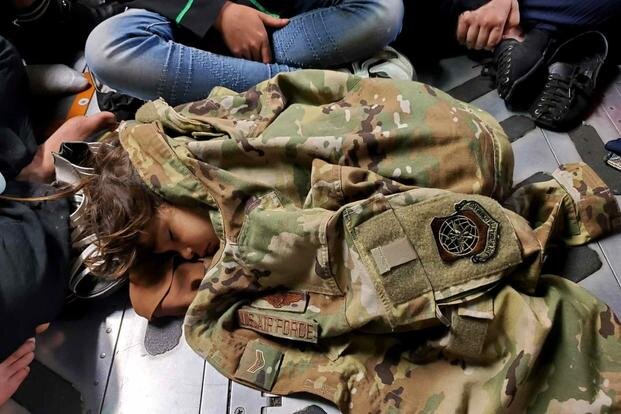There’s no question that the botched U.S. efforts to evacuate at-risk people in Afghanistan is the big story of the hour, the day, the week and for the foreseeable future — especially if this turns into a grand-scale hostage nightmare.
But who is at risk? What kinds of people are trapped inside the new kingdom of the Taliban?
That was the subject that dominated this week’s “Crossroads” podcast (click here to tune that in). And as you would expect, host Todd Wilken and I were especially interested in the role that religion has been playing in this story — if journalists are willing to cover that angle.
So who is at risk? Here is a typical wording, care of an Associated Press update:
The Kabul airport has been the focus of intense international efforts to get out foreigners, Afghan allies and other Afghans most at risk of reprisal from the Taliban insurgents.
With the Taliban controlling the Afghan capital, including the airport’s outer perimeter, White House national security adviser Jake Sullivan said that U.S. citizens are able to reach the airport, but were often met by large crowds at the airport gates.
But, wait. What about the news reports that U.S. forces cannot help U.S. citizens avoid Taliban checkpoints in order to reach the airport, while British and French military personnel are doing precisely that for their own people? That’s a very hot story right now, with U.S. diplomats and the White House saying that the can work with the Taliban to ensure safety.
So let’s pause and flesh out some of the details in that AP phrase about who is at risk, as in “foreigners, Afghan allies and other Afghans most at risk.” Who is most at risk, right now?
* Obviously, American journalists have every right to focus on risks to American citizens.
* In particular, we can assume that Taliban activists are tracing Americans who have led or worked with NGOs, religious aid groups, churches. Then there are the Western-style think tanks, schools, medical groups, etc.
* Obviously, there are the thousands of Afghans who cooperated with and even worked for the U.S. government, U.S.-backed Afghan military units and the kinds of “foreign” organizations mentioned in the previous item.
Afghan girls beg American soldiers at the airport to save them from what they know is coming. pic.twitter.com/KQyxULaXXp
— David Patrikarakos (@dpatrikarakos) August 18, 2021
* Also at risk: Women and girls who, during the past 20 years, stepped outside the doctrinal fences surrounding the Taliban’s view of sharia law and Islam in general. Were groups dedicated to women’s issues able to destroy their membership rolls and other records?
Taliban PR agents — look for them on Twitter, of all places — have gone out of their way to say that they have changed their approach to the lives of women (within the boundaries of their take on sharia law). Here is a typical passage on that, from a recent Washington Post report:
In some ways, the Taliban has evolved, adapting for instance to the Internet and social media era. Thomas Ruttig, co-director of the Afghanistan Analysts Network, argued earlier this year in a research paper that although the group has “softened their rhetoric on some issues” such as women’s rights, the changes are largely the product of political pressure rather than shifting beliefs. …
Suhail Shaheen, a spokesman for the Taliban’s political leadership, told The Post this spring that the group was “committed to women’s rights, whether they are in terms of [access to] education or work.” But in Taliban-controlled areas, women are still often barred from working outside their homes, and girls may not have any school to go to.
* What about Afghans who responded to U.S. programs to empower the LGBTQ+ community? Remember that Pride flag over the U.S. Embassy throughout the month of June?
For example, what what is the status of the Afghans to led or took part in this recent think-tank program? Can we assume that the Taliban is seizing the records — those that have not been destroyed — of these organizations, as well?

* What about the leaders of moderate and progressive Muslim congregations, hospitals, publishers, schools and other associated community organizations? As GetReligion has long stressed, often citing the work of human-rights scholar Paul Marshall (see “Silenced: How Apostasy and Blasphemy Codes are Choking Freedom Worldwide,” an essential book), the Taliban and other Islamist groups are quick to persecute other Muslims who get in their way.
* Finally, what about the threats against members of minority religious groups — such as the growing number of Christians in Afghanistan? Will U.S. officials consider appeals for religious asylum in the weeks and months ahead?
At the moment, the big story is the chaos surrounding evacuation flights. It’s safe to say that, eventually, this will evolve into U.S. efforts to pay ransom money to the Taliban (kidnapping is a key part of the group’s MO) in order to aid U.S. citizens.
That development will draw lots of news coverage, as it should.
But let’s end by asking this: Will American journalists (European journalists are another issue) focus lots of attention on that story if it appears to be hurting the administration of President Joe Biden?
So far, journalists have — as they should — produced waves of coverage of the threats to Afghan women. Will editors call for similar coverage of the LGBTQ+ community, especially if the Taliban publicly attacks Western efforts on Sexual Revolution issues?
Finally, will issues of religious persecution, including Christians, be covered by the mainstream press or will those murders and jailings be considered “conservative stories” and, thus, they will appear only in independent religious publicans?
Just asking.
Stay tuned. Let us know what you see in the coverage, for better and for worse. And enjoy the podcast. Please ase, pass it along to others.
FIRST IMAGE: Afghan child asleep on a U.S. military evacuation flight. Official U.S. Air Force photo posted at Military.com













